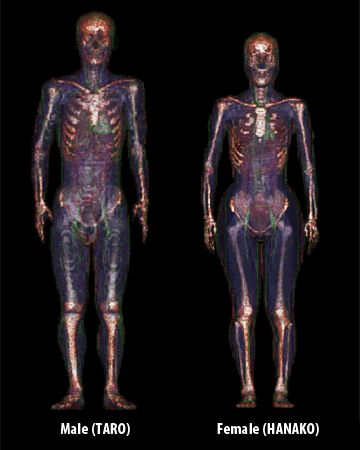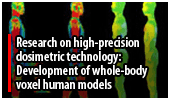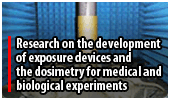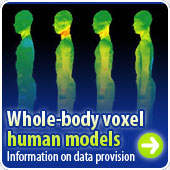Development of whole-body voxel human models
Japanese adult male and female whole-body voxel human models

Three-dimensional display of whole-body voxel human models
No. of tissues: 51 types for both male and female models
Body shape: That of the average Japanese male and female
Whole-body voxel human models depict the shape of the human body (tissues and organs) as an aggregate of minute elements. Each minute block, or voxel, is labeled with a tag representing the name of a tissue or an organ such as muscle or fat, and assigned with the electrical properties of the respective tissue/organ. By applying electrical constants that correspond to a specific tissue or organ, it is possible to simulate how radio waves are absorbed by the human body.
Under collaborative efforts undertaken with Kitasato University, Keio University, and Tokyo Metropolitan University, NICT has developed Japan's first whole-body voxel human models that have the average body shape of Japanese adult men and women. Named Taro (male) and Hanako (female), these models possess 2 mm spatial resolution and 51 tissues and organs, based on the accumulated MRI images of adult Japanese volunteers of average build (height and weight). After the whole-body voxel human model were developed, they underwent medical supervisions and analyses of anatomical data. The results showed that these human-body model databases were superior to those that had been developed in the past in terms of spatial resolution and the number of tissues and organs identified, and that the dimensions of various parts of the body as well as organ weights were close to those of average Japanese people. Incidentally, Hanako, the female model, is the world's first whole-body voxel model to have spatial resolution in millimeter units.
These models are not merely used to investigate the interaction between radio waves and the human body. By defining the elastic, radiation absorption, and other parameters specific to each tissue or organ, they can be adapted for numerical simulations in various fields of research. For example, the model may be used for simulation tests of damage suffered by passengers in crash tests, and for drawing up radiation treatment plans for cancer patients.
At present, these models are available to the public, both free of charge (for non-commercial and/or research purposes) and for a fee (for commercial purposes).
Comparison with other models
| Organization | Sex | Height (cm) | Weight (kg) | Num. of Tissues | Voxel Size (mm) |
|---|---|---|---|---|---|
| NICT (TARO) | M | 173.2 | 65 | 51 | 2 x 2 x 2 |
| NICT (HANAKO) | F | 160.8 | 53 | 51 | 2 x 2 x 2 |
| HPA (NORMAN) | M | 176.0 | 73 | 37 | 2 x 2 x 2 |
| HPA (NAOMI) | F | 163.0 | 60 | 41 | 2 x 2 x 2 |
| Utah Univ. | M | 176.4 | 71 | 29 | 2 x 2 x 3 |
| Victoria Univ. | M | 177.0 | 76 | 34 | 3.6 x 3.6 x 3.6 |
| Brooks AFB | M | 187.1 | 105 | 43 | 1 x 1 x 1 |
- Japanese adult male and female whole-body voxel human models
- Child voxel models
- Pregnant woman voxel models
- Posture-independent voxel models






